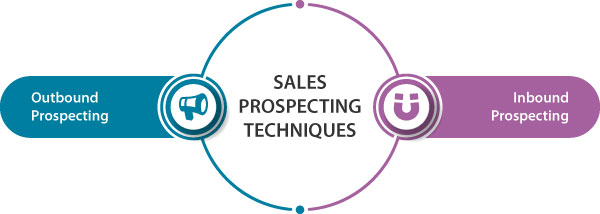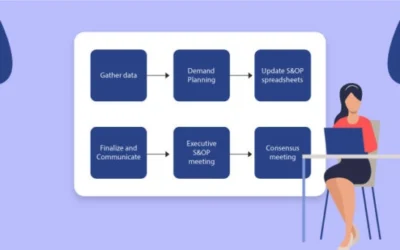What is Sales Prospecting: Definition, Techniques, and Steps!
One of the crucial sales processes is sales prospecting, which is the foremost step in the sales funnel. It involves identifying your prospects, developing a database of their details, and then communicating with them with the aim of transforming them into customers. It can be tough to do this if a sales rep doesn’t have an idea of what to expect or how to execute it effectively.
This blog tells you more about sales prospecting, its importance, the techniques employed, and how it is done.
What is sales prospecting?

Sales prospecting is the process where sales representatives reach out to leads in anticipation of creating sales opportunities. They may employ different techniques such as direct messaging, cold emailing, cold calling, and other ways to nurture existing leads that have become inactive or reach entirely new prospects.
Importance of sales prospecting
Sales prospecting is an indispensable part of any sales strategy. For, it generates qualified new leads to whom businesses can sell to. Its foremost importance lies in the fact that it keeps your business growing by filling your sales pipeline.
If you wonder what a sales pipeline is, it is a visual representation of each step that your sales rep has to take to move a deal from its start to its close. Every business should have one. For, it helps you know who you are targeting, what has been accomplished, and what is in progress. If your business doesn’t have a sales pipeline to date, do create one as soon as possible.
Another way in which sales prospecting helps a business is by revealing trends. With each email, each call, and each social media message, they find new things about introducing themselves and providing value to the prospects.
And yet another importance of sales prospecting is that it increases productivity. By tracking the outcomes of your team’s prospecting efforts in a CRM, you recognize its strengths and weaknesses. Over time, this facilitates discovering inefficiencies and fixing those. Further, it also acts as a system of measurement that keeps you and your team motivated.
Besides, with sales prospecting, you find and work on your ideal prospects, rather than waste your efforts and resources on unfitting prospects. This enables your team to focus on those accounts that matter. For, good fit prospects provide long-term business and value than the unfitting ones.
Furthermore, it is highly effective too. Studies say that more than 7 in 10 buyers really want to hear from sales reps in the initial stages of the buying process. And 82% of buyers agree to meet (in person or over a call) when a sales rep reaches out first. So, well-performing sales prospectors generate almost 3X sales than those who do not prospect or are low performers.
Finally, sales prospecting also provides you with competitive insights in this highly competitive era. For, interacting with your prospects lets you know where your products and services stand in the crowd of competitors. You can utilize those insights to make your marketing operations and campaigns more efficient.
Sales prospecting techniques

Studies say that sales reps waste 50% of their sales time on unfruitful prospecting. This wastage can be detrimental to your business. So, your sales team needs knowledge of the proper sales prospecting techniques to make the most of their time and eliminate unproductive hours.
There are two broad categories of sales prospecting techniques.
- Outbound Prospecting
- Inbound Prospecting
Outbound Sales Prospecting
Outbound sales prospecting is a conventional technique where sales reps carry out intense research about their target market and deliver their sales pitch to individual prospects. The common methods used in outbound prospecting are cold calling, cold emailing, social spamming, and dropping-in.
- Cold calling: In this method, sales reps make unsolicited calls to prospects with the intention of selling a product or service.
- Cold emailing: This involves sending unsolicited emails to prospects without any previous contact. By employing email marketing best practices, you can have a winning situation.
- Linkedin Outreach: involves sending contact requests to relevant prospects or leveraging LinkedIn automation tools to efficiently connect with and engage potential clients on the platform.
- Social spamming: In social spamming, sales reps post unwanted content related to their product or services on social networking sites.
- Dropping-in: Involves face-to-face interaction of the sales rep with a prospect to deliver a sales pitch.
Inbound Sales Prospecting
Inbound prospecting is where prospects reach out to your business, most probably due to the info they heard about you over the internet.
Inbound sales prospecting largely involves the use of a Customer Relationship Management (CRM) software to gain a detailed idea of how the prospect initially got to your site, what pages he or she viewed, and the actions he or she took (like commenting on a blog post or subscribing to your email), etc.
This knowledge facilitates your sales team with a comprehension of the prospects’ needs and purchase intent. Some common methods employed for inbound prospecting are warm emailing, social selling,
- Warm emailing: Sales team starts prospecting to those leads who have approached their site by introducing themselves via email. You can employ email marketing automation if you have a large business generating a huge number of leads.
- Social selling: Sales team nurtures leads and seeks new prospects by posting relevant content and comments on social media.
Steps involved in sales prospecting
A study says that more than 40% of sales representatives find prospecting to be the toughest part of sales. The chief cause is the inadequacy of the provision of guidelines to the salespeople from the firm or organization where they work.
So, here are the key steps to practice while sales prospecting.
1. Know your prospects
The foremost step in sales prospecting is to define the criteria of prospects of your company. You should identify whether the people you are targeting have the intent and means to purchase what you’re selling. This is necessary. Else you would be wasting your time and resources on those who neither need the product nor the funds to pay for it.
You can use the BANT quantification. BANT stands for Budget, Authority, Need, and Time. Get to know if what you are selling is purchasable by the prospect, whether he has the authority to make a buying decision, whether he/she needs the product, and if the buying Timing is right (For this, do some research on the buying cycle).
2. Research
Once you have a clear picture of your ideal customer, you need to start researching your ideal sources. Today, with the extensive use of the internet, there are a variety of sources from where you can get new leads for your business. These sources can be different social networking sites, purchased lists, official records, directories, business magazines, trade shows, etc.
However, you may not find your ideal customers from all of these. And it would be a waste of time and resources to search all the platforms. So, find what your ideal source is. For instance, if you are selling to a well-educated community, then Facebook and LinkedIn prospects will be great. This will help you come up with a highly targeted and relevant list of prospects to target.
3. Prioritize prospects
Prioritizing your prospects can save you time and effort. It will also make sure that you first reach out to those prospects with the highest likelihood to convert. You can prioritize your list of prospects by looking at your existing customers and identifying similarities. You can look for commonalities in terms of industry/vertical, earnings, family size, decision maker’s persona, location, etc.
After recognizing the similarities that typically influence the purchase, make a list of indicators to determine replica prospects. This will help you prioritize your high-value prospects with precision.
4. Tailor your outreach
Now that you have prioritized your prospects, it’s time to contact them. You can employ any technique under inbound or outbound sales prospecting to make the first move. Irrespective of the method used, you should tailor your message to your prospect’s vertical, needs, goals, or business. Research says that 61% of buyers dislike pushy sales reps.
So, rather than directing your efforts toward making a sale, focus on turning them into your customers. So, help your prospect with the business-related issue they are facing. Keep the customer interaction natural and provide them with helpful resources. Be prepared to respond respectfully to the oppositions that they are likely to put up.
5. Build relationships
The ultimate aim of prospecting is to open up and explore the association between the prospect and the company and decide whether both sides can mutually benefit from the alliance. To work on your relationship-building skills, you should always record the interaction between your sales rep and prospect.
Later on, you can replay the session to find your strengths, weaknesses, and challenges that you might not have paid heed to. Thus, it will help you polish your sales prospecting process and come up with a system to aid salespeople to become more successful.
6. Ask for referrals

Your customer network can be a great resource to tap potential customers. So, after building a strong relationship with a prospect or customer, ask if they can refer their colleagues, friends, and folks. This is one of the excellent sales techniques that most top-performing sales reps are consistently doing.
Asking for referrals makes the process of obtaining prospects easy. Further, referrals are also your most reliable new prospects. For, they have come to you via word-of-mouth marketing. Studies say that firms with referrals enjoy 69% faster close times and 70% higher conversion rates. So, prospect smartly by asking for referrals.
7. Build your social media presence

If your business has been online for a while, you certainly would have recognized the importance of being in the social media for today’s businesses. Your social media presence adds to your prospecting arsenal and social media is here to stay. So, find those social networking channels where most of your potential buyers are on and start getting involved in them.
Create your business’ profile on those channels and post informative and useful posts regularly. Also, find forums and groups where you can answer questions or reply to comments. By offering genuine expertise in your niche, you will not only educate your audience but also generate the trust and attention of your prospects. This way, even before you speak to them, you would have progressed a few steps in the buyer journey.
Final words….
Always keep in mind that there is no one-size-fits-all solution when it comes to sales prospecting. For, the response from a prospect is the ultimate product of complex human emotions, behaviors, and attitudes. So, you may hear a ‘no’ even after you employ all kinds of expert strategies. Even then don’t give up. Work on building relationships, which often takes time but is always productive. The key is to be consistent in your endeavor of bringing in prospects and converting them to customers. For executive sales recruiters, this approach will lead to long-term success.



